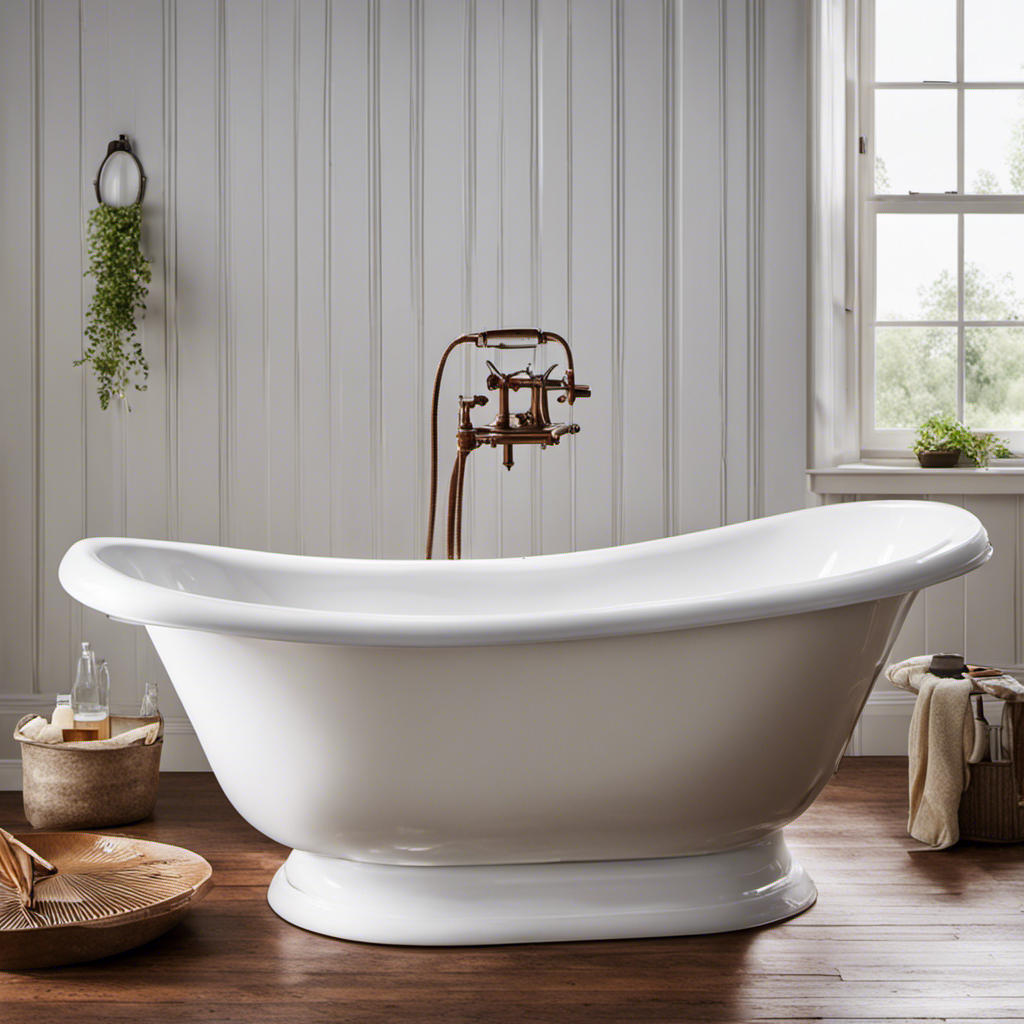I’m here to show you how to transform your plastic bathtub into a work of art that will make you feel like you’re soaking in a luxurious spa.
Painting a plastic bathtub may seem daunting, but with the right tools and techniques, it can be a rewarding project. In this guide, I’ll walk you through the process step by step, giving you all the tips and tricks you need for a smooth and even finish.
Get ready to give your bathroom a makeover like never before!
Key Takeaways
- Choose paints specifically designed for plastic surfaces, such as ‘bath and tub paint’ or ‘plastic bathtub paint’.
- Thoroughly clean and dry the surface before painting, using mild detergent, sponge, and scrub brush.
- Follow proper painting techniques, including sanding the surface, applying primer, multiple coats of acrylic enamel paint, and a clear topcoat.
- Avoid common mistakes like not sanding the surface properly, using the wrong type of paint, applying too thick of a coat, and not allowing enough drying time between coats.
Choosing the Right Paint for Your Plastic Bathtub
Choosing the right paint for your plastic bathtub can be tricky, but it’s essential for a successful and long-lasting result. When it comes to painting a plastic bathtub, it’s important to use a paint that is specifically designed for this purpose. Look for paints that are labeled as ‘bath and tub paint’ or ‘plastic bathtub paint’ to ensure compatibility with the material.
These paints are formulated to adhere well to plastic surfaces and provide a durable finish that can withstand the constant exposure to water and cleaning products. Additionally, consider the painting techniques you plan to use, such as brush or spray application, as this may affect the type of paint you choose.
It’s also worth noting that if you have an alternative bathtub material, such as acrylic or fiberglass, you may need to use different paint and preparation techniques.
Now that we understand the importance of choosing the right paint, let’s move on to preparing your bathtub for painting.
Preparing Your Bathtub for Painting
Before starting, make sure you’ve thoroughly cleaned and dried the surface. This step is crucial to ensure proper adhesion of the paint.
To prepare your bathtub for painting, gather the necessary cleaning supplies such as a mild detergent, sponge, and scrub brush. Begin by cleaning the surface with the detergent and warm water, removing any dirt, grime, or soap scum. Rinse thoroughly and allow the surface to dry completely.
It’s important to take safety precautions during this process, such as wearing gloves and eye protection. Additionally, ensure proper ventilation in the area by opening windows or using fans.
Step-by-Step Guide to Painting Your Plastic Bathtub
To achieve a smooth and professional finish, start by lightly sanding the surface of your plastic tub. This step is crucial as it helps the paint adhere better and ensures a long-lasting result. After sanding, make sure to thoroughly clean the tub to remove any dust or residue. Now you’re ready to begin painting your plastic bathtub. Here is a step-by-step guide to help you through the process:
- Apply a primer specifically designed for plastic surfaces. This will create a smooth base for the paint and enhance its durability.
- Once the primer is dry, apply multiple coats of acrylic enamel paint, allowing each coat to fully dry before applying the next.
- Use a brush or roller to evenly distribute the paint, making sure to cover all areas of the tub.
- Finally, apply a clear topcoat to protect the paint and give it a glossy finish.
By following these steps, you can transform your plastic bathtub into a beautiful focal point in your bathroom. However, there are some common mistakes to avoid when painting a plastic bathtub:
| Mistake | Solution |
|---|---|
| Not sanding the surface properly | Lightly sand the tub before painting to ensure proper adhesion. |
| Using the wrong type of paint | Use acrylic enamel paint specifically formulated for plastic surfaces. |
| Applying too thick of a coat | Apply thin, even coats of paint to avoid drips and uneven surfaces. |
| Not allowing enough drying time | Follow the manufacturer’s instructions for drying times between coats. |
While painting is the most common method for transforming a plastic bathtub, there are alternative methods you can consider:
| Method | Description |
|---|---|
| Bathtub liners | These are custom-made liners that fit over your existing tub, providing a new surface. |
| Bathtub refinishing kits | These kits typically include a bonding agent and a topcoat that can be applied to the tub’s surface. |
| Professional refinishing services | Hiring professionals to refinish your bathtub can give you a high-quality and long-lasting result. |
Remember to choose the method that best suits your needs and budget. With proper preparation and the right products, you can successfully paint your plastic bathtub and give it a fresh, new look.
Tips and Tricks for a Smooth and Even Finish
For a smooth and even finish, it’s important to apply thin coats of paint and allow each coat to dry completely before applying the next. This ensures that the paint adheres properly and reduces the chance of drips or brush marks.
To achieve the best results, here are some tips and tricks:
-
Use sanding techniques to prepare the surface before painting. This helps to remove any existing paint or imperfections, creating a smooth base for the new paint to adhere to.
-
Allow sufficient drying time between each coat. This can vary depending on the type of paint and environmental conditions, so be sure to check the manufacturer’s recommendations.
-
Avoid rushing the drying process by using fans or heaters, as this can lead to uneven drying and affect the final result.
-
Consider using a primer specifically designed for plastic surfaces. This will help the paint bond better and ensure a long-lasting finish.
By following these tips, you can achieve a smooth and even finish on your painted plastic bathtub.
Now, let’s move on to the next section about maintaining and caring for your newly painted bathtub.
Maintaining and Caring for Your Painted Plastic Bathtub
Remember, it’s important to regularly clean and gently scrub your newly painted tub to maintain its pristine appearance. Cleaning and removing old paint is crucial in preventing peeling and chipping. Here are some tips to help you care for your painted plastic bathtub effectively:
| Cleaning Method | Frequency | Tools Needed |
|---|---|---|
| Mild Soap and Water | Weekly | Soft Sponge or Cloth |
| Vinegar Solution | Monthly | Spray Bottle, Vinegar, Water |
| Baking Soda Paste | Bi-Monthly | Baking Soda, Water, Soft Brush |
To remove old paint, carefully scrape it off using a plastic scraper. Avoid using harsh abrasive cleaners or scrub brushes that can damage the painted surface. When cleaning, always rinse thoroughly to remove any residue. Regular maintenance will ensure your painted plastic bathtub stays beautiful and lasts longer.
Conclusion
In conclusion, painting a plastic bathtub is a great way to give it a fresh new look. By choosing the right paint and properly preparing the surface, you can achieve a smooth and even finish that will last for years.
With the right maintenance and care, your painted bathtub can continue to look beautiful and vibrant. So don’t be afraid to take on this DIY project – the results may just be a coincidence of beauty and skill that you never expected.










